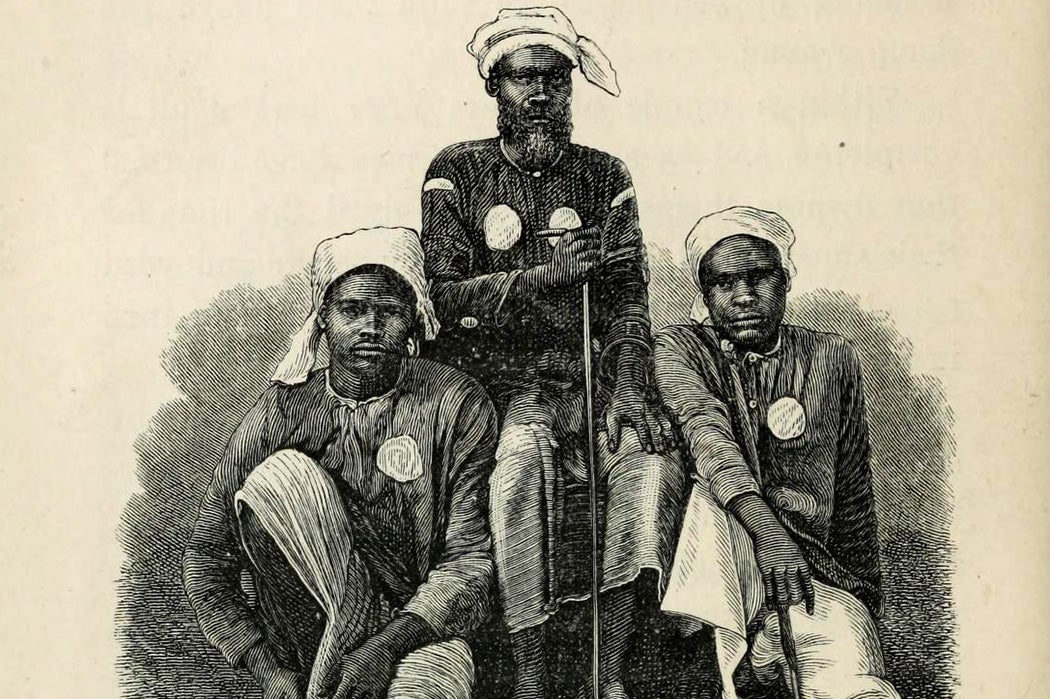In nineteenth-century Britain, rumors about “the curse of the Nile” abounded. As Nezar AlSayyad points out, most explorers who sought the great river’s source not only failed in their mission, they also met untimely and unfortunate ends. James Bruce died alone after tumbling downstairs. Richard Burton was upstaged by his travel partner John Hanning Speke, who ultimately shot himself. David Livingstone disappeared while trying to solve the Nile mystery. However, there was one who seemed immune to the curse: Mbarak Mombée, who died peacefully in 1885 at age sixty-five.
It’s been estimated that Mombée, a WaYao (Bantu) man born in the Ruvuma Region of southern Tanzania around 1820, traveled in excess of 9,600 land miles through Africa’s interior. He arguably had a greater impact on the mapping of the continent’s east than anyone else. His diplomacy with tribal chiefs, knowledge of the terrain, and capacity with medicine proved vital to many of the most lauded African expeditions of the nineteenth century, including those that revealed Lake Tanganyika and Lake Victoria. London’s Royal Geographical Society eventually offered him a medal and small pension in recognition of his bravery. However due to his race, he’s usually remembered as a supporting character in the biographies of his white counterparts and always with the name conferred by those who enslaved him: Sidi Murabak Bombay.
Mombée grew up on the border of present-day Tanzania and Mozambique, living with his father. But Arab traders kidnapped him when he was around twelve years old and dragged him to Zanzibar, where he was sold for cloth and thrown on a ship bound for India. He never saw his father or village again. It would be two long decades before his enslaver died and Mombée returned to Zanzibar, where he took a job working for the state’s first sultan.
It was in Zanzibar, in 1856, that Mombée met Speke, a British explorer who was acting as second-in-command to the more famous Burton. The duo had been tasked with identifying the source of the White Nile, the holy grail of African exploration since Herodotus attempted a search around 460 BCE. Mombée and Speke built a rapport in Hindi, and he was soon employed as a guide.
Mombée emerged as a leader among the approximately 200 Africans in the caravan. In his journal, later published as Personal Narrative of a Pilgrimage to Al Madinah and Meccah—Volume 1, Burton described Mombée as
a very singular character, not caring one bit about himself, how he dressed or what he ate; ever contented, and doing everybody’s work in preference to his own, and of such exemplary honesty he stands a solitary marvel in the land: he would do no wrong to benefit himself—to please anybody else there is nothing he would stick at.
Initially, Speke and Mombée communicated solely in Hindi, but Mombée eventually added English, Arabic, and Kiswahili to his lexicon, which proved vital when it came to negotiating safe passage with tribal leaders. At points, both Speke and Burton were so ill that Mombée had to lead their donkeys.
When Speke became the first European to reach Lake Victoria in Uganda in 1858, it was Mombée who was at his side rather than the still sickly Burton. Although he couldn’t prove it, Speke had a hunch that this was indeed the source of the White Nile. Furious at being robbed of his prize, Burton started a smear campaign against Speke and Mombée back in Britain. When Speke returned to Africa alone three years later, it was he and Mombée who joined forces to discover that Lake Victoria eventually connected with the Nile River.
A decade later, in 1869, Mombée led the cigar-smoking, Welsh American journalist Henry Morton Stanley to the banks of the Tanganyika. Their mission, which they achieved successfully, was to track down the Scottish explorer David Livingstone, who had been “missing” for four years (Livingstone’s journal and other contemporary accounts alternately paint a picture of a man confidently seeking the source of Nile; pathetically felled by illness and isolation on the shores of Lake Tanganyika; and contentedly enjoying the food and women in the village of Nyangwe, on the western flank of today’s Democratic Republic of the Congo.)
At age fifty-three, Mombée’s final expedition was arguably his most daring: in 1873 he and Verney Lovett Cameron embarked on what would be a two-year journey, ultimately crossing equatorial Africa from Zanzibar to Angola. It was the first recorded time any traveler had achieved this feat.
Weekly Newsletter
Notably, when Mombée was awarded his silver medal by the Royal Geographical Society in 1876, he wasn’t invited to Britain to collect it. However, his dotage was arguably less troubled than those of his white teammates. He spent the remainder of his life doing what he loved best: traveling Africa and spreading the word of Christ across the continent.
Today, Mombée is still better known as Sidi Mubarak Bombay. According to the Royal Geographic Society, Mombée’s enslaver gave him the name “Mubarak.” And Sarah Longair writes that the other two names also refer to his enslavement and transport to India: “Sidi” is used in India to refer to descendants of African migrants, and “Bombay” speaks to his education in Bombay Presidency after his emancipation. As the historical records of European expeditions in Africa show, though he was a much-needed guide and translator, his name scarcely appears in the formal record. But even if it had, it would have been a name marked by enslavement and colonialism. At least we know his final missions were on his own terms, not those of his enslaver.







